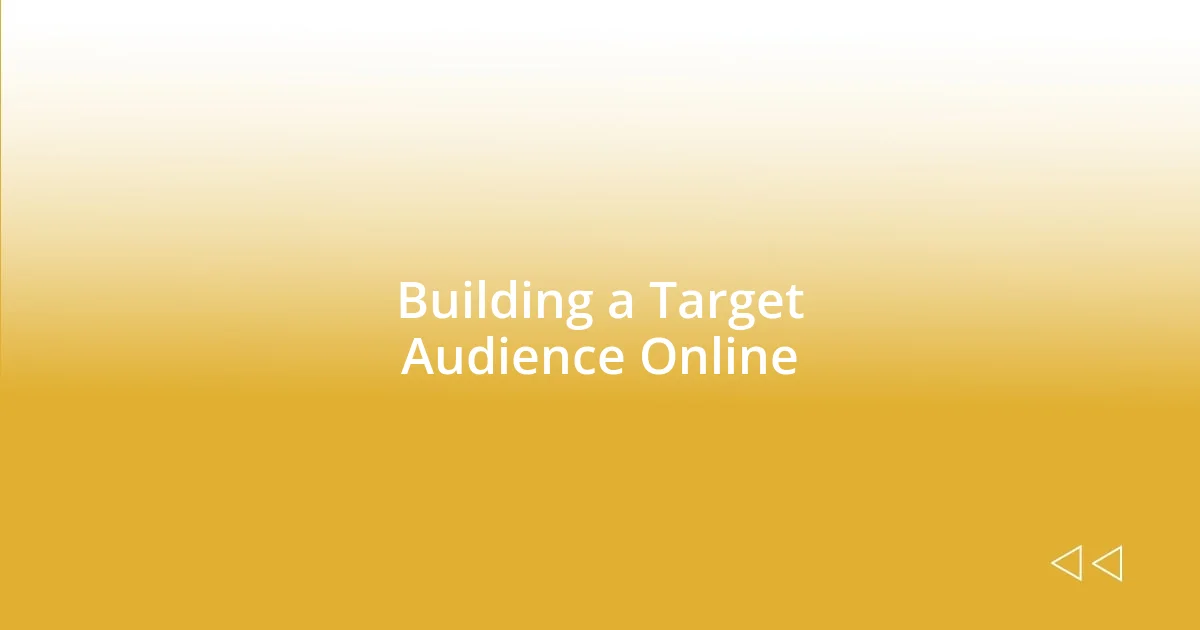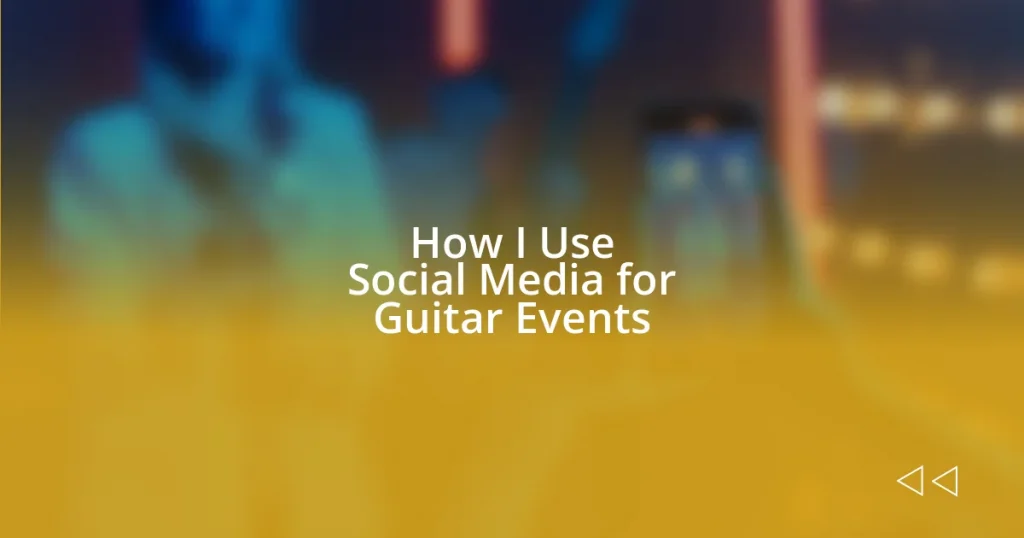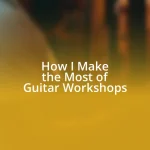Key takeaways:
- Select the right social media platforms, such as Instagram and Facebook, to effectively showcase events and engage with audiences.
- Create engaging content through behind-the-scenes insights, storytelling, and videos to strengthen connections and increase visibility.
- Utilize collaboration, hashtags, and follow-up strategies to foster community engagement and gather valuable feedback for future improvements.

Choosing Appropriate Social Media Platforms
Selecting the right social media platforms for your guitar events can feel overwhelming with so many options. Personally, I lean towards Instagram and Facebook because they allow me to showcase vibrant photos and connect with fellow musicians. Have you ever noticed how a simple post of a jam session can spark conversations and collaborations?
I once posted a short video of a group rehearsal on Facebook, and it ignited a wave of excitement among my local guitar community. The platform’s event feature helped me reach a larger audience, making it easier to inform fans and gather everyone for a live performance. Have you experienced that kind of participation and engagement on any social media platform?
On the other hand, I’ve found that platforms like TikTok can be a double-edged sword. While they offer incredible potential for viral content, the fast-paced nature can sometimes overshadow meaningful connections. Have you thought about how the platform aligns with your audience? Choosing wisely ensures your message resonates with the people you want to reach.

Creating Engaging Content for Events
Creating engaging content for guitar events is all about sharing experiences that resonate with your audience. I often find that behind-the-scenes content works wonders. For instance, I once shared a sneak peek from a songwriting session where we were experimenting with new sounds. The genuine excitement we expressed drew in viewers who felt connected to our process. It’s incredible how people appreciate being part of your musical journey. Have you tried this approach?
Another strategy I love is storytelling through posts. Last year, I recounted a memorable gig where everything went wrong—from a broken string to unexpected weather—but instead of focusing on the challenges, I highlighted the unforgettable camaraderie and laughter we shared. My followers engaged with the post, sharing similar stories and creating a dialogue. It turns out that vulnerability and authenticity can transform a simple update into a compelling narrative that captivates and unites your audience.
Visual content, especially videos, can unleash a new level of engagement. I remember capturing an impromptu jam session that turned into a mini-concert. I posted it on Instagram with a casual caption inviting people to join our next rehearsal. The response was thrilling! The excitement of seeing real moments in music makes people more likely to attend future events. Have you embraced video content in your strategy? It might just elevate your event’s visibility and connection with fans.
| Type of Content | Engagement Level |
|---|---|
| Behind-the-Scenes | High |
| Storytelling | Very High |
| Visual Videos | Exceptional |

Building a Target Audience Online
Building a target audience online requires a blend of strategy and authenticity. I’ve learned that engaging with people directly is vital. For instance, I once hosted a live Q&A session on Instagram where I invited guitar enthusiasts to ask any questions about playing techniques. The interaction was amazing! Participants opened up about their challenges, and I found myself building genuine connections while attracting followers who truly resonated with my content.
To effectively cultivate your audience, consider these proactive approaches:
- Consistent Interaction: Regularly respond to comments and messages. It shows you care.
- Themed Posts: Create weekly themes; for example, “Technique Tuesday” can draw interest and anticipation.
- User-Generated Content: Encourage your followers to share their own progress or experiences. It makes them feel involved and valued.
- Polls and Surveys: Use Instagram Stories to gauge interests and preferences; it opens the dialogue.
- Collaborations: Partner with local artists or businesses for cross-promotions, amplifying your reach.
By employing these tactics, I’ve found my community steadily growing, filled with passionate individuals eager to join my musical journey. It’s really fulfilling to see how a little effort can create lasting relationships online.

Utilizing Hashtags for Event Promotion
Utilizing hashtags effectively is a game changer for promoting guitar events. I distinctly remember launching a local gig and researching trending music hashtags. By using tags like #LiveMusic and #GuitarLovers, I reached audiences I hadn’t connected with before. It was incredible to see new faces show up simply because they discovered our event through a hashtag search! Have you ever thought about how a simple phrase can change the way people find your content?
I also learned the importance of creating a unique hashtag for specific events. For one concert, I crafted #StrumAndJam2023 and encouraged attendees to use it while posting their own experience during and after the show. When I checked after the event, I was genuinely surprised to see hundreds of posts under that hashtag! This not only fostered community engagement but also created lasting memories that others could revisit. It’s like giving your event its own voice in the vast social media landscape. Isn’t that an exciting thought?
Don’t underestimate the power of local hashtags too. While promoting a recent open mic night, I tagged specific neighborhoods and cities, like #NYCGuitarists and #BrooklynMusicScene. The result? A wave of local musicians and enthusiasts came out to show support. I will forever remember the warm atmosphere that filled the venue that night. It made me realize that tailoring hashtags to your specific audience is not just smart; it’s essential in this interconnected world. Have you tapped into your local vibe with your hashtags? It could make all the difference!

Analyzing Engagement and Feedback
Analyzing engagement and feedback on social media is crucial to understanding how your audience connects with your content. I remember the thrill of checking my event posts after a gig, only to find a flood of comments praising the performance. Each interaction was like a mini celebration; it helped me gauge what resonated with my audience and where I could improve. Have you ever felt that rush when you see your hard work recognized?
One of the most insightful ways I analyze feedback is through the comments section. It’s fascinating to see which posts spark the most conversation. For instance, during a recent live stream, someone shared a personal struggle with mastering a particular guitar technique. Their sharing opened a floodgate of others relating their own experiences, collectively creating a supportive community. It reminds me that every comment is an opportunity to connect deeper. Are you paying attention to what your audience is telling you, even in between the lines?
Moreover, I often utilize analytics tools to dive into engagement metrics like shares, likes, and comments rates. After my last event, I analyzed the data and discovered that my video highlights received a 40% higher engagement than static posts. It made me rethink how I approached content creation. Now, I focus more on dynamic content to engage my audience. Isn’t it empowering to let data guide your creative decisions while still keeping the human element alive?

Collaborating with Influencers and Musicians
Collaborating with influencers and musicians can elevate your guitar events in unexpected ways. I once teamed up with a local guitarist who had a modest following, and we created joint posts showcasing our rehearsal sessions. The outcome surprised me; his audience was intrigued, and it led to a significant turnout at our next gig. Have you ever considered how a collaboration might expand your reach and strengthen community ties?
In another instance, I reached out to a well-known guitarist for a one-off live session. To my delight, not only did they agree, but they also shared the event across their social media platforms. It was exhilarating to see new audiences pouring in from their follower base. It made me realize the power of alliances; one connection can spark interest from a larger network. How often do you think about who you could partner with to amplify your efforts?
I’ve also found that building meaningful relationships with influencers can lead to creative opportunities beyond individual events. A friend in the industry once turned a casual jam session into a regular series, bringing in guest musicians to collaborate. We not only gained a larger audience but also enriched our own musical experiences. Isn’t it amazing how collaboration not only grows your network but also deepens your artistic journey?

Following Up After the Event
After the event, I believe it’s essential to reach out to everyone who participated, whether through direct messages or public posts. I recall a moment after one of my guitar showcases when I took the time to thank attendees for their support. I noticed several fans sharing their favorite moments from the night, and it felt rewarding to see that connection thrive even after the performance ended. Have you ever felt that warm sense of community when you engage with your audience afterward?
I also make it a point to share photos and videos from the event on my social media profiles. On one occasion, I posted a candid shot of the crowd enjoying the show, and the response was overwhelming! People tagged their friends and shared stories from the night, creating a ripple effect that kept the energy alive long after the last chord had been played. Isn’t it interesting how a single image can reignite those shared experiences and foster deeper engagement?
Additionally, I find it invaluable to seek feedback directly from my audience post-event. I often create a simple poll or questionnaire to gather insights on what they enjoyed most and what could be improved. After doing this for a recent event, I was surprised to discover that many attendees appreciated the behind-the-scenes content I had shared during the performance. This little effort not only improved my future events but also made my audience feel heard and valued. How often do you seek feedback to refine your approach, knowing that it can lead to even more meaningful engagements?















